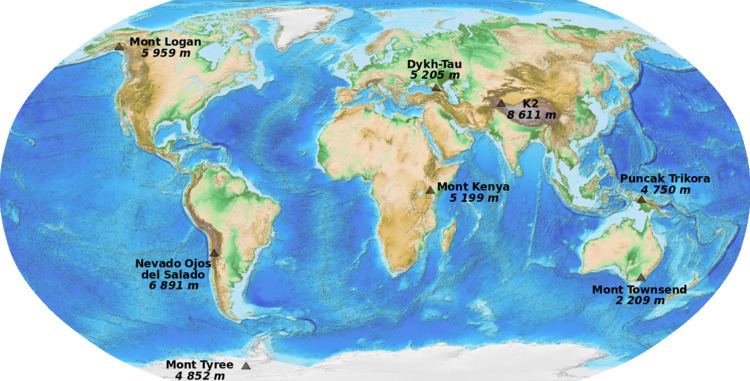 | ||
The Seven Second Summits are the second highest mountains of each of the seven continents. All of these mountain peaks are separate peaks rather than a sub-peak of the continents' high point.
Contents
Austrian mountaineer Christian Stangl became the first person to successfully climb the "Second Seven Summits".
Stangl climbed all possible candidates for the Second Seven Summits quest (K2, Mt. Logan, Ojos del Salado, Batian, Mt. Tyree, Dych Tau, Dufourspitze, Sumantri, Ngga Pulu, Puncak Trikora, Puncak Mandala and Mt. Townsend) to exclude any errors and to satisfy all geographers. He finished the quest on January 15th 2013 and was certified by Guinness World Records on September 17th 2013. Later he also completed the Challenge for the Triple Seven Summits.
The Seven Second Summits are considered by many mountaineers and geographers as a much harder challenge than the traditional Seven Summits.
Seven Second Summits definitions
The definition of continent is a matter of some dispute among mountaineers seeking to complete this challenge.
The main ridge of the Greater Caucasus range is generally considered to form the boundary between Europe and Asia. In that case, Mount Elbrus (5,642 m (18,510 ft)) situated some 10 km north of the continental divide, is the highest mountain in Europe. Excluding the Caucasus Mountains, Mont Blanc (4,808 m (15,774 ft)) would be Europe's highest mountain.
The Australian continent is defined as comprising the mainland of Australia and proximate islands on the same continental shelf, including Tasmania and New Guinea. In the convention of the seven continents, one of the continents is the region of Australasia, which includes for example the mountainous islands of New Zealand. For both the geological and conventional continent, New Guinea's Carstensz Pyramid (4,884 m (16,024 ft)) is the highest summit. When considering a continent as a continuous landmass surrounded by oceans, mainland Australia would be its own continent, with Mount Kosciuszko (2,228 m (7,310 ft)) as its highest summit.
The Bass and Messner list
The Second Seven Summits list follows the Seven Summits list created by Richard Bass , who chose the highest mountain of mainland Australia, Mount Kosciuszko (2,228 m), to represent the Australian continent's highest summit. Reinhold Messner proposed another list (the Messner or Carstensz list) replacing Mount Kosciuszko with Western New Guinea's Carstensz Pyramid, which is part of Indonesia (4,884 m).
Following the Bass list, Mount Townsend is the second highest summit (2,209 m) in Australia. According to the Messner list, Puncak Mandala (4,760 m) on New Guinea is the second highest of the Australian continent. Heights of mountain peaks in West Papua are poorly established, and Puncak Trikora has been listed as the second highest summit on the island, but SRTM-data do support a higher elevation for Mandala.
Both lists count Mount Elbrus as the highest peak in Europe. This makes Dykh-Tau (5,205 m), located in Russia, the second highest summit in Europe. Those who consider Mont Blanc to be the highest mountain in Europe would consider Monte Rosa (4,634 m), located in Switzerland, to be the second highest summit.
Difficulty versus Seven Summits
Alpinism author Jon Krakauer wrote in Into Thin Air that it would be a bigger challenge to climb the second-highest peak of each continent instead of the highest.
In Asia, K2 (8,611 m) demands greater technical climbing skills than Everest (8,848 m), while altitude-related factors such as the thinness of the atmosphere, high winds and low temperatures remain much the same.
In Africa, the summit of Mount Kenya (5,199 m) is a rock climb, while Mount Kilimanjaro (5,895 m) can be ascended without any technical difficulty.
In North America, some sources consider Mount Logan a more difficult climb than Denali, although the climbing and outdoor recreation website Summitpost considers Logan no more difficult than Denali, because it is neither technical nor steep.[1] Mountaineer Mark Horrell, in a 2012 post on his blog, considered Mount Logan to be no more difficult technically than Denali, but much more difficult to approach. Denali's base camp, at 2,200 m elevation, is regularly served by air, while climbers without the means to charter a plane face a hike of at least 100 km to reach Mount Logan.
In South America, Ojos del Salado involves a short scramble while Aconcagua is just a walk. Horrell acknowledged that Ojos del Salado was more technically difficult, but considered Aconcagua a greater challenge because of physical demands. Aconcagua's base camp, at 4,500 m, is accessible by mule, but from that point climbers must carry all of their supplies to as many as three higher camps before the final ascent. By contrast, Ojos del Salado is accessible by four-wheel-drive vehicles to 5,200 m; from that point, climbers need only carry supplies to a mountain hut at 5,800 m before making their final push to the summit.
In Europe, Dykh-Tau is a considerably harder climb than Mount Elbrus.
In Australasia, the continent's Second Summit on the Bass list, Mount Townsend, is more challenging than Mount Kosciuszko, but still just a walk-up. The normal route on the highest peak of the Messner list, Carstensz Pyramid, is technically difficult (UIAA grade V+). Puncak Mandala, however, is extremely challenging with respect to the approach route, which is arguably the more significant problem in climbing the New Guinea peaks. There have been perhaps only two successful approaches (and climbs) reported.
In Antarctica, Mount Vinson presents little difficulty beyond normal challenges of Antarctica (the guiding company Adventure Peaks rates the ascent at PD/AD on the Alpine scale), but Mount Tyree requires technical climbing and it has been climbed by a total of ten people since its discovery.
